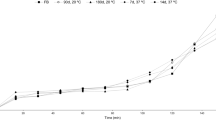Abstract.
The tendency to radical formation as an early event in lipid oxidation was used to characterise the oxidative stability of processed pork in an assay based on the spin trapping technique and electron spin resonance (ESR) spectroscopy. Pork cooked at different temperatures was evaluated, and it was found that heating at 95 °C resulted in higher radical formation than heating at 70 °C or at 120 °C. The tendency to formation of radicals (identified as carbon-centered radicals from the hyperfine coupling constants) was found to correlate with the rate of oxygen depletion as measured electrochemically, and the ESR assay should be further explored as a tool for the prediction of oxidative stability of meat products.
Similar content being viewed by others
Author information
Authors and Affiliations
Additional information
Revised version: 9 April 2001
Electronic Publication
Rights and permissions
About this article
Cite this article
Carlsen, C.U., Andersen, M.L. & Skibsted, L.H. Oxidative stability of processed pork. Assay based on ESR-detection of radicals. Eur Food Res Technol 213, 170–173 (2001). https://doi.org/10.1007/s002170100357
Received:
Issue Date:
DOI: https://doi.org/10.1007/s002170100357




